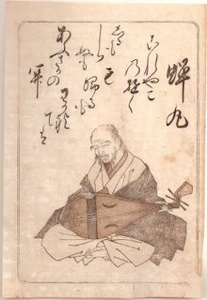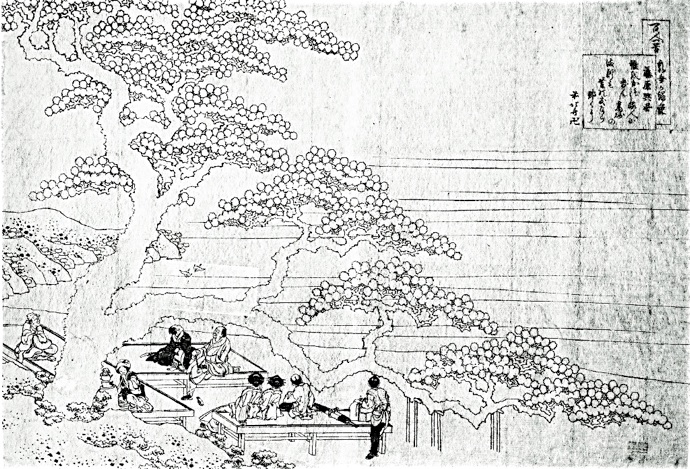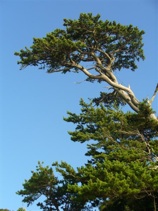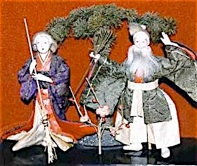藤原興風


誰をかも
知る人にせむ
高砂の
松も昔の
友ならなくに
ふじわらのおきかぜ
たれをかも
しるひとにせん
たかさごの
まつもむかしの
ともならなくに
Fujiwara no Okikaze
Who might be around still
Who are known to me?
Also the Takasago pines
I cannot call my friends
To pine away with.
Hokusai
Fujiwara no Okikaze (dates unknown; he must have reached an old age), was a middle Heian waka poet and Japanese nobleman. He is one of the Thirty-Six Immortal Poets.
Takasago is famous for its shrine dedicated to Susano-no-Mikoto and Kushinadahime-no-Mikoto, who were ancient gods as well as a married couple. Within its confines, Aioi pines and a Noh stage are preserved. Sometimes Kangetsu Noh (Noh by moonlight) is held here.
The Takasago legend is one of the oldest in Japanese mythology. An old couple - his name is Jo and hers is Uba known together as Jotomba - are said to appear from the mist at Lake Takasago.
The old man and his wife are usually portrayed talking happily together with a pine tree in the background. Signifying, as they do, a couple living in perfect harmony until they grow old together, they have long been a symbol of the happiness of family life. The story is portrayed in a famous Noh play ‘Takasago no Uta’. See also here.
At Takasago Shrine there is a very old pine tree, the trunk of which is bifurcated; in it dwells the spirit of the Maiden of Takasago who was seen once by the son of Izanagi who fell in love and wedded her. Both lived to a very great age, dying at the same hour on the same day, and since then their spirits abide in the tree, but on moonlight nights they return to human shape to revisit the scene of their earthly felicity and pursue their work of gathering pine needles. His pine tree is also called ‘The Pine of Sumi-no-e’ and hers is the Takasago pine.
The old woman is using a broom to sweep away trouble and he carries a rake to rake in good fortune. In Japanese this is also a play of words with ‘One Hundred Years’ (haku - sweeping the floor) and ‘until 99 years’ (kujuku made - kumade, meaning a rake).
Pine trees are the symbol of long life as they can grow very old. The Japanese word for pine also means ‘wait’.



Matsu, pine tree

It is disputed whether the poem refers to the place Takasago or just means ‘a high dune’ as the name in itself suggests. Anyway, this poem is by now strongly linked to Takasago and the legends around it.
Naranaku is either an inversion of nakunaru, ‘to pass away’ or naranu, ‘of no help’. It seems to me that the poet is lamenting his friends who have passed away, but also that the pines will outlive him, they will not wait for him and stand him by like friends.
In Hokusai’s time Takasago already was a tourist site, and his drawing shows people - including a monk - visiting the famous pine tree. A woman is preparing tea for them.

Jo and Uba dolls